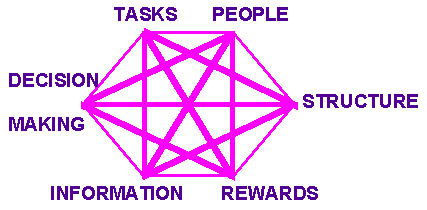|

| |
Step 5 : Other
Considerations
|
The diagram below illustrates six elements which combine to affect the culture of an
organisation [the Galbraith model]. Introducing a change to one of these six elements can
have knock-on effects to other elements. For example, a church which wanted to change its
choir into a music group found that the resistance to the idea had very little to do with
the new styles of music, to which the singers were looking forward, but more to do with
the singers no longer being required to wear choir robes, something which made them feel
important! The church allowed them to continue wearing the robes, and over time affirmed
them in their musical gifts, to the point where a year later the choir suggested that they
should no longer robe! 
|
|
Let's look at the six elements in a
little more detail :
TASKS - Tasks covers all the activities that people do as
part of their work - very often this is the initial focus for change. For example, one UK
hospital looking to simplify its activities examined how many people it actually took to
change a light bulb. They discovered it took six people to carry out the seventeen tasks
necessary to authorise, obtain and fit a new light bulb.
PEOPLE - Secondly, we consider the people involved. Whose
jobs will change? How will they feel about it? Will the change affect the membership of
the organisation - e.g. by bringing in new church members?
STRUCTURE - What organisational framework is in place around
the process? How are people organised? What are the policies of the organisation? Changing
the structure is often essential in any major change. A parish with a single parish church
engaged in planting a new church on a housing estate, found that nearly all its structures
needed to change as a result.
REWARDS - What are the actual reward criteria? This covers
not just pay, but what makes people happy, what keeps them a part of the organisation?
Very often, informal reward systems are more powerful than formal reward systems. The
example of choir robes on the previous page would fit into this section.
INFORMATION - What information is essential for the smooth
running of the organisation in the area of the change? Many churches function on
remarkably little information! Introducing a change can be an opportunity to review
whether sufficient information is being gathered, e.g. on new members, or frequency of
hymns sung, etc and if necessary to do something about it.
DECISION MAKING - How are decisions made ? What authority is
delegated to those working in the process? Really?
|
| USING THE
MODEL - Think about the change that you are introducing, and try and identify the
major components of it. For each of the components, identify what will alter for each of
the six elements in the Galbraith model. Then go through them, and identify what action,
and what additional communication, is required. |

This material is copyright to The Teal Trust, (www.teal.org.uk) © 2002, but
may be reproduced with permission for non-profit use.
|
|

